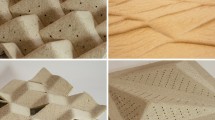Abstract
In view of the increasing shortage of resources as well as growing ecological damage, the aspects of the exploitation of raw materials and the recovery after the end of the lifetime of products have to increasingly be taken into consideration. In addition, the aspect of saving energy by means of lightweight constructions must also be regarded. The use of conventional, i.e. petrochemically-based plastics and fibre-reinforced polymers, the production process, as well as usage and recovery are often very difficult and demand considerable technical resources. An answer to solve all these problems may be provided by natural fibre-reinforced biopolymers based upon renewable resources, called biocomposites in the following. By embedding plant fibres, e.g. from flax, hemp, or ramie (cellulose fibres) into biopolymeric matrices, e.g. derivatives from cellulose, starch, shellac, or plant oils, fibre-reinforced polymers are obtained that can be integrated into natural cycles in an environmentally-friendly manner, e.g. by classic recycling, by CO2-neutral incineration (including recovery of energy), and possibly by composting.
Access this chapter
Tax calculation will be finalised at checkout
Purchases are for personal use only
Preview
Unable to display preview. Download preview PDF.
Similar content being viewed by others
References
Michaeli, W., and Wegener M., 1990, Einführung in die Technologie der Faserverbundwerkstoffe. Hanser Verlag publishing company, Munich.
Carlsson, L.A., and Byron Pipes, R., 1989, Hochleistungsfaserverbundwerkstoffe — Herstellung und experimentielle Charakterisierung. B.G. Teubner-Verlag publishing company, Stuttgart.
Moser, K., 1992, Faser-Kunststoff-Verbund. VDI-Verlag GmbH publishing company, Düsseldorf.
Ehrenstein, G.W., 1992, Faserverbund-Kunststoffe. Carl Hanser Verlag publishing company, Munich.
DIN 60 001, 1990, Textile Faserstoffe — Naturfasern. Deutsches Institut für Normung (German Institute for Standardisation), Berlin.
Wagner, E., 1961, Die textilen Rohstoffe (Natur- und Chemiefaserstoffe). In Teil T12 Handbuch für Textilingenieure und Textilpraktiker, Dr. Spohr-Verlag publishing company Wuppertal-Elberfeld.
Flemming, M., Ziegmann, G., and Roth, S., 1995, Faserverbundbauweisen, Fasern und Matrices. Springer-Verlag publishing company Berlin Heidelberg, pp. 155–179.
Kromer, K.-H., Gottschalk, H., and Beckmann, A., 1995, Technisch nutzbare Leinfaser. In Landtechnik 6: 340–341.
Schliefer, K., 1975, Zellulosefaser, natürliche. In Ullmanns Encyklopädie der technischen Chemie, 4th edition, Publishing company: Verlag Chemie, Weinheim, Vol. 9: pp. 247–253.
Gessner, W., 1955, Naturfasern Chemiefasern. Fachbuchverlag, specialised books publishing company, Leipzig.
N.N., 1955, Volume IV. Technik 1.Teil. Landolt-Börnstein, 6th edition, pp. 158–295.
N.N., 1955, Volume IV: Technik 1.Teil. Landolt-Börnstein, 6th edition, pp. 322–420.
N.N., 1994, Flachs sowie andere Bast- und Hartfasern, Faserstoff-Tabellen nach P.-A. Koch. Special print from the chemical fibre/textile industry, 44th/96th year, Deutscher Fachverlag GmbH publishing company, Frankfurt/Main.
Haudek, H. W., and Viti, E., 1980, Textilfasern. Verlag Johann L. Bondi & Sohn publishing company, Wien-Perchtoldsdorf, Melliand Textilberichte KG, Heidelberg, pp. 15–73.
Haudek, H. W., and Viti, E., 1980, Textilfasern. Verlag Johann L. Bondi & Sohn publishing company, Wien-Perchtoldsdorf, Melliand Textilberichte KG, Heidelberg, pp. 122–141.
Haudek, H. W., and Viti, E., 1980, Textilfasern. Verlag Johann L. Bondi & Sohn publishing company, Wien-Perchtoldsdorf, Melliand Textilberichte KG, Heidelberg, pp. 156–161.
Ruge, J., 1989, Technologie der Werkstoffe, Vieweg-Verlag publishing company, Braunschweig.
Seifert, H.-J., 1969, Fallschirmwerkstoffe. In Fallschirmtechnik und Bergungssysteme. (Publishers H.-D. Melzig), lecture series from DGLR-DFVLR-AGARD.
Fritz, H.-G., 3rd-.4th Sept. 1997, Innovative Polymerwerkstoffe unter Einbeziehung nachwachsender Rohstoffe. In Werkstoffe aus nachwachsenden Rohstoffen, Conference proceedings of the 1st International Symposium, Rudolstadt. Publishers Thüringisches Institut fiir Textil- und Kunststoff-Forschung e.V., Rudolstadt.
Aichholzer, W., 3rd-44th Sept. 1997, Bioabbaubare Faserverbundwerkstoffe auf der Basis nachwachsender Rohstoffe. In Werkstoffe aus nachwachsenden Rohstoffen, Conference proceedings of the 1st International Symposium, Rudolstadt. Publishers Thüringisches Institut fiir Textil- und Kunststoff-Forschung e.V., Rudolstadt.
Bastioli, C., 11th-12th Feb. 1998, Starch based bioplastics: Properties, applications and future perspectives. In Biologisch abbaubare Werkstoffe (BAW), Conference Proceedings of Symposium, Würzburg.
Rapthel, I., and Kakuschke, R., 3rd-4th Sept. 1997, Entwicklungen und Eigenschaften von Sconacell A als vollständig abbaubare Kunststoffe auf Basis teilacetylierter Naturstärke. In Werkstoffe aus nachwachsenden Rohstoffen. Conference proceedings of the 1st International Symposium, Rudolstadt. Publishers Thüringisches Institut fiir Textil- und Kunststoff-Forschung e.V., Rudolstadt.
N.N., 1997, Bioceta — Biologisch abbaubares Zellulosediacetat. Kunststoff + Kautschuk Produkte 97/98. Yearly Handbook of the Processors, Recycling Companies, Deliverers and Furnishers, Publishing company Darmstadt, pp. 176–177.
Eicher, T., and Fischer, W., 1975, Zelluloseester. Ullmanns Enzyklopädie der technischen Chemie. 4th Edition, Volume 9, Publishing company Verlag Chemie, Weinheim, pp. 227–246.
Kuhne, K., 29th-30th June 1998, Neue Thermoplaste auf Zellulosebasis. In International Wood and Natural Fibre Composites Symposium. Proceedings of the symposium, Kassel, Publishers Universität Gesamthochschule Kassel, lecture 13.
Schack, D., 11 th-12th Feb. 1998, Polyhydroxybutyrat/valerat Copolymere. In Biologisch abbaubare Werkstoffe (BAW). Conference proceedings of the symposium, Würzburg.
Scherzer, D., June 1997, Pflanzenfaserverstärkte Polyurethanschäume in industriellen Anwendungsbereichen. In Neue Produkte aus pflanzlichen Fasern. Branchendialog, Mainz, Publishers Bildungsseminar für die Agrarverwaltung Rheinland-Pfalz.
Utz, H., 19th-20th Nov. 1992, Bioabbaubare Kunststoffe im Verpackungsbereich. In Biologisch abbaubare Kunststoffe. Conference Proceedings of Symposium No. 16105/56.253, Esslingen.
Fritz, H.-G., Seidenstücker, T., Bölz, U., Juza, M., Schroeter, J., and Endres, H.-J, 1994, Study on production of thermoplastics and fibres based on mainly biological materials. EUR 16102, Directorate-General XII Science, Research and Development.
Witt, U., Müller, R.-J., and Klein, J., 1997, Biologisch abbaubare Polymere. Study of the Franz-Patat-Zentrums für Polymerforschung e. V., Braunschweig.
Herrmann, A. S., Nickel, J., and Riedel, U., 1998, Construction materials based upon biologically renewable resources — from components to finished parts. In Polymer Degradation and Stability 59, pp. 251–261.
Riedel, U., and Nickel, J., 1999, Natural fibre-reinforced biopolymers as construction materials — new discoveries. In Die Angewandte Makromolekulare Chemie, 272: 34–40.
Riedel, U., 1999, PhD Thesis Entwicklung und Charakterisierung von Faserverbundwerkstoffen auf Basis nachwachsender Rohstoffe. Fortschritt-Berichte VDI, 5, 575.
Riedel, U., and Gensewich, C., 1999, Pultrusion von Konstruktionswerkstoffen aus nachwachsenden Rohstoffen. In Die Angewandte Makromolekulare Chemie, 272: 11–16.
Author information
Authors and Affiliations
Editor information
Editors and Affiliations
Rights and permissions
Copyright information
© 2001 Springer Science+Business Media New York
About this chapter
Cite this chapter
Nickel, J., Riedel, U. (2001). Structural Materials Made Of Renewable Resources (Biocomposites). In: Chiellini, E., Gil, H., Braunegg, G., Buchert, J., Gatenholm, P., van der Zee, M. (eds) Biorelated Polymers. Springer, Boston, MA. https://doi.org/10.1007/978-1-4757-3374-7_3
Download citation
DOI: https://doi.org/10.1007/978-1-4757-3374-7_3
Publisher Name: Springer, Boston, MA
Print ISBN: 978-1-4419-3369-0
Online ISBN: 978-1-4757-3374-7
eBook Packages: Springer Book Archive




